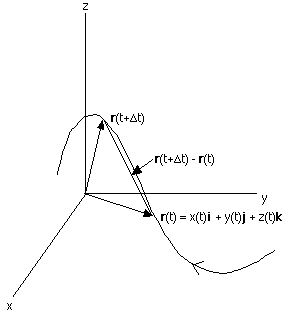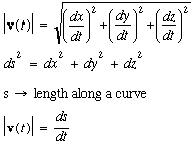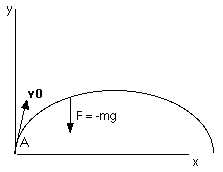|
Velocity

The velocity of a curve is the derivative of the vector function defining
the curve:

The velocity is always tangent to the displacement curve.
Suppose you had a curve with a kink:
 What would the velocity be at the
Kink? What would the velocity be at the
Kink?
Answer: It would not exist, since the derivitive is not continuous at that
point.
Speed
The speed of a vector function is the magnitude of it's velocity, as
described by the equations below:

One can find the direction of the velocity as the unit vector tangent to the
curve. That is:
dir v = v/|v|.
One should also note that every curve will have two unit tangent vectors at
any point. The direction of the unit tangent vector found in the previous
equation depends on the direction in which t is increasing. The unit tangent
vector found will always point in the direction of increasing t. To find the
second unit tangent vector, multiply the first by -1.
Acceleration
a(t) = x''i + y''j + z''k
Projectile Motion

Let's Find r(t).
F = ma = mr''
-mgj = mr''
r'' = -gj
r' = -gtj + C1
Using the initial conditions of v = r' = V0,
at t = 0, we find that C1 = V0, so
v(t) = -gtj + V0
v(t) = -gtj + V0 cos(A) i + V0 sin(A) j
r(t) = (-g*t^2)/2 j + V0t + C2
Again, using intial conditions, for t = 0, r = 0, we find that
C2 = 0
r(t) = (-g*t^2)/2 j + t*V0*cos(A)i
+ t*V0*sin(A)j
Or, in Scalar (Parametric) form:
x(t) = tV0 cos(A)
y(t) = (-g*t^2)/2 + tV0 sin(A)
A Quick Review of Projectile Quantities
- The Trajectory is a parabola:
Eliminate t from the parametric equations using:
t = x/(V0 cos(A))
and, let n = V0 cos(A)
So, y = (-g/2)(x/n)^2 + (x/n) V0 sin(A)
Thus, y is a quadratic function of x, and we have a parabola.
- Height, Flight Time and Range:
- Max. height:
This is reached when vy = 0
We solve for the time, t, where this occurs:
vy =
0 = -gt + V0 sin(A)
t = V0 sin(A)/g
So, ymax =
(-g/2)(V0 sin(A)/g)^2 + (V0 sin(A))^2/g =
(V0 sin(A))^2 / 2g
- Flight Time and Range:
The flight is over when y = 0.
We solve the following equation to get the time:
y = 0 = (-g*t^2)/2 + tV0 sin(A)
t = 2 V0 sin(A) / g
The range, R = xf, where xf =
the position where the flight ends is:
R = V0^2 (2 sin(A) cos(A))/g =
= V0^2 sin(2A) / g
Derivatives of Vector Functions
d/dt(u (dot) v) = u (dot) d/dt(v) +
v (dot) d/dt(u)
d/dt(uxv) = d/dt(u) x v + u x d/dt(v)
dR/ds = dR/dt * dt/ds = (dR/dt)/(ds/dt) =
= velocity / speed = unit tangent vector
Written by Lawrence C. Weintraub on 2/21/95
Edited by Milos Borojevic on 2/21/95
Send Comments to lcw5@cornell.edu or mb49@cornell.edu
|